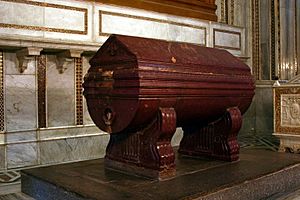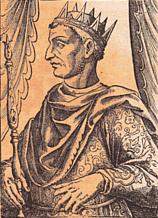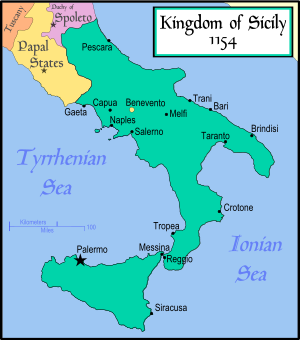William I of Sicily facts for kids
Quick facts for kids William I |
|
|---|---|
| King of Sicily | |
| Reign | 26 February 1154 – 7 May 1166 |
| Predecessor | Roger II |
| Successor | William II |
| Born | 1120 or 1121 Palermo, Kingdom of Sicily |
| Died | May 7, 1166 Palermo, Kingdom of Sicily |
| Burial | Monreale Cathedral |
| Spouse | |
| Issue |
|
| House | Hauteville |
| Father | Roger II of Sicily |
| Mother | Elvira of Castile |
William I (born 1120 or 1121, died May 7, 1166) was the second king of Sicily. He ruled from 1154 until his death in 1166. People sometimes called him "the Bad" or "the Wicked."
William was the fourth son of King Roger II and Queen Elvira of Castile. The nickname "the Bad" might not have been fair. It probably came from a historian named Hugo Falcandus and some powerful nobles who didn't like William's government.
Contents
Early Life and Becoming King
William was the son of King Roger II of Sicily. His grandfather was Roger I of Sicily, a famous count. William didn't expect to become king because he had three older brothers.
However, his brothers, Roger, Tancred, and Alfonso, all passed away between 1138 and 1148. This meant William became the next in line. When his father died, William was still not fully ready to take on the big job of being king.
William's Time as King
When William became king, he kept many of the same people in charge who had helped his father. Only one person, Thomas Brun, was removed. The main person in charge was Maio of Bari, who became the ammiratus ammiratorum. This was the highest position in the kingdom.
Maio continued his father's plan to keep nobles from having too much power in the government. This made many nobles upset. They were also angry because Maio tried to limit the freedom of towns.
Challenges from Other Rulers
Powerful leaders like Pope Adrian IV, the Byzantine Emperor Manuel I Comnenus, and the Holy Roman Emperor Frederick I encouraged the nobles to rebel.
In late 1155, Greek troops took back several cities in Italy, including Bari and Brindisi. William quickly gathered his army and navy. On May 28, 1156, he defeated the Greek forces at Brindisi and took back Bari.
Making Peace and Losing Land
After this victory, Pope Adrian IV made a deal with William. They signed the Treaty of Benevento on June 18, 1156. The Pope recognized William as the rightful king and stopped supporting the rebels.
In 1157, William sent a large fleet of 164 ships with 10,000 men to attack areas controlled by the Greeks. In 1158, William made peace with the Greeks.
While William was successful in Europe, his kingdom lost control of lands in North Africa to the Almohads. A revolt started in Sfax in 1156 and spread quickly. In 1159, William sent a fleet to attack the Balearic Islands. However, no more help was sent to the Christians in Mahdia, a city in Africa. Mahdia surrendered in 1160, ending William's "African empire."
Rebellion and Family Tragedy
Maio's policies led to a big plot against the king. In November 1160, Maio was killed in Palermo by Matthew Bonello, a leader of the Sicilian nobles. The nobles wanted a weaker king and hoped to replace William with his oldest son, Roger IV, Duke of Apulia.
After Maio's murder, the royal palace was attacked by William's own relatives. These included his half-brother Simon and his nephew Tancred. King William and his family were captured.
For a short time, William was held by the people who wanted to remove him from power. But the people and the army supported him. William regained control, defeated the rebels, and punished Bonello. Sadly, during the attack on the palace to free the king, William's son Roger was killed by an arrow.
Later Years and Legacy

After the rebellions, William put trusted men in charge of his government. These included Matthew of Ajello and Bishop Palmer of Syracuse. His last years as king were peaceful.
William supported Pope Alexander III against the Holy Roman Emperor. In November 1165, Norman guards helped Pope Alexander III take his place in the Lateran Palace.
William died on May 7, 1166. He was first buried in Palermo Cathedral. Later, his son and heir, William II of Sicily, moved his body to Monreale Cathedral after it was finished.
William and his wife, Margaret of Navarre, had four sons:
- Roger IV, Duke of Apulia (1152–1161)
- Robert III, Prince of Capua (1153–c. 1160)
- William II of Sicily (1153–1189)
- Henry, Prince of Capua (1158–1172)
Stories About Constance
There are some different stories about William's half-sister, Constance. Some old writings say that when Constance was born, a monk predicted she would cause the destruction of Sicily. Because of this, William supposedly forced her to become a nun so she couldn't marry or have children.
However, other historians disagree. They say Constance was raised in the royal palace, not a monastery. They also suggest she might have been sent to a convent for her safety during a rebellion against William, but she was not a nun. She later married and became Queen of Sicily.
See also
 In Spanish: Guillermo I de Sicilia para niños
In Spanish: Guillermo I de Sicilia para niños



